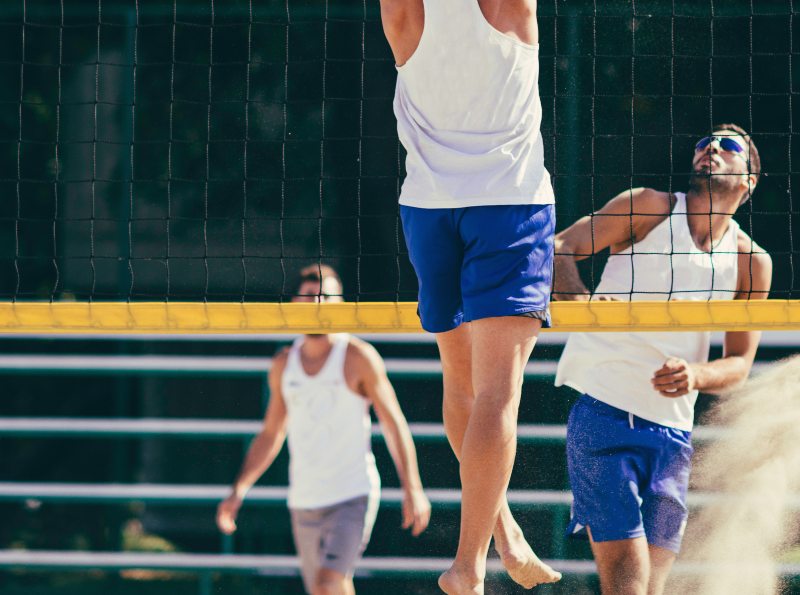
We all know that the main part of the body used in volleyball are the hands. However, it happens quite rarely to see a player hit the ball with his head by accident or even rarely on purpose.
But, can you use your head in volleyball? There is nothing that forbid the use of head in volleyball, whether on purpose or by accident. In fact, according to the rules of the sport, as laid down by the FivB (Féderation Internationale de Volleyball), the official governing body of the sport, the ball may touch any part of the body when in play.
In this article, I give your more helpful details about this subject, as well as other legal touches that you can totally perform during practice and actual games.
More about using head in volleyball?
In reality, playing the ball with the head happens once in a while in actual games, particularly in net play when spikers are attempting to smash the ball and blockers from the other side are trying to stop them …
In that circumstance it is not unusual for the ball to bounce off a head and for then play to continue as normal.
And when a spike does clear the net, defenders on the other side in the back court can get caught in the face or the top of the head by the ball if they cannot get out of the way in time.
There may also be situations where playing the ball with the head is the only way to keep a play alive. In such circumstances, it is legal to use whatever available part of the anatomy.
Quick Recommendation: To learn more about other volleyball rules that few people (even players) know about, I invite you to check this helpful volleyball book. You will learn a lot not only about that, but also about some
What if the ball touches the head by accident?
Yes, it is legal to use the head – deliberately or otherwise – whether it is wise to do so is another matter entirely.
That is because a team only gets three contacts before the ball has to be passed over the net to the other side. And that means each contact should be aiming to put a team in the best possible position to score a point.
Is it recommended to use your head in volleyball?
Volleyball players are not like their counterparts in soccer who practice heading on a regular basis …
Indeed, Heading is a difficult skill to master anyway, and it is much more difficult to control the ball with the head than the arms.
Any contact in volleyball where the best attempt is not being made to control the ball is wasted.
And there may be other long-term health reasons to avoid heading the ball! Now volleyballs are lighter than soccer balls and, in theory, pose less of a risk.
And, given that the top players can hit a volleyball at speeds approaching 80 mph (130 km/h), frequent blows to the head could pose unquantified long-term risks.
At the same time, the fact that a volleyball is lighter than a soccer ball makes it inherently harder to control anyway, so using the hands to the head is always preferable.
What about beach volleyball?
While there are differences between indoor and beach volleyball:
- Court size
- Number of players
- Positions
- Scoring system
It is essentially the same game when it comes to the rules!
One area where the two variants of the sport differ is with regard to the ball. An indoor ball weighs between 9.2 and 9.5 ounces, and between 25.5 to 26.5 inches in circumference. It is smaller and heavier than an outdoor ball, enabling it to be hit harder and move through the air quicker.
By contract, a beach volleyball feels lighter and gives the impression of floating through the air.
It is also constructed differently. An indoor volleyball is glued together with individual panels to give a smooth surface, whereas the beach equivalent is glued together and feels softer.
All this makes a beach volleyball harder to control anyway, so the hands should always be used when available.
Although the rules are essentially the same, a block does count as a touch in beach volleyball. That means there may be even less opportunities to get the ball back over the net, putting even more premium on making each one count.
Other legal touches in volleyball
Basically, as already stated, it is legal to use almost any part of the body in volleyball – this means, for example, that not only is using the head legal, but it would also be within the rules to use the shoulders, chest, thighs, torso, or even to kick the ball.
The reason why volleyball players do not use other parts of the body more often comes back to the rules of the sport, and the fact that only three contacts – excluding the block – may be made on one side of the net before it has to be passed over to the opposition.
Each of those contacts has to count – from the serve retrieval or dig, through to the set and then the spike.
It is much easier to control the ball with the hands rather than any other part of the anatomy.
This is particularly true of the set. The ball needs to be passed to the hitter at exactly the right speed and accuracy so that they can either generate the right power or use their skill to dink the ball over the outstretched hands of the opposing blockers.
Using any other part of the body when the hands are available is just wasteful and extravagant.
It may be something which can be done for fun in an exhibition game or a non-competitive match between friends, but it is something that would be frowned-upon in a real-life match situation.
Ideas on some illegal touches in volleyball …
There are a number of touches that are regarded as illegal according to the rules of volleyball.
An assisted hit, for example, where a playing within the playing area gets help from a teammate – or a surrounding structure – when attempting to hit the balls is not allowed. In such cases a fault will be called and the other team awarded a point.
However, a player can get help from a colleague to stop them touching the net or crossing the center line.
Catching or throwing the ball is also strictly against the rules. Should a player be caught doing either then the referee will stop the play, declare an illegal contact, and award the point to the opposing team.
Players are also not allowed to touch the ball twice in succession – a double contact. For example, somebody who digs the ball up after it come over the net, may then not set it as well…
And a player may not contact the ball with various parts of the body in succession – for example, their example, their head, and then their hands.
An exception to this rule, in indoor volleyball at least, is that they can hit the ball again after making a block, as blocks do not count towards a team’s three contacts.
Reaching beyond the net is also prohibited. A player cannot reach beyond the net to make an attack spike while the ball is on their opponent’s side of the net. Blockers are allowed to make contact beyond the net provided that they do not interfere with the play of the opponents.
Attackers may also reach beyond the net after connecting with the ball if their momentum carries them there.
Finally, there is the category known as illegal attack hits. For example, a player in the aback court may not make an attack hit from the front zone while the ball remains above the top of the net …
And players from either the front or back zone are not allowed to attack the serve of an opponent while the ball remains above the top of the net.
There are also specification rules regarding the defensive specialist “the libero” …
They are now allowed to make an attack hit from either zone of the court whilst the ball remains above the height of the net …
And, in the event that the libero makes a pass using an overhand finger manoeuvre, then other players may not attack the ball whilst it remains above the top of the net.
It is worth mentioning that Blocking a serve in volleyball in not allowed! Check the article … It is simple and useful.
Final Thoughts
In this article, I thought it would be too bad to only talk about heading the ball in volleyball. Instead I took it as an opportunity to talk also about other moves that are legal as well as other moves that are forbidden …
This should give you an idea on how the whole sport works, so you will make sure to stick to the rules and not be confused by some moves that are totally authorized.
Finally, I highly invite you to check those 2 articles:
- Importance of standing in sidelines for volleyball players.
- Pros and Cons of using glasses in volleyball.
